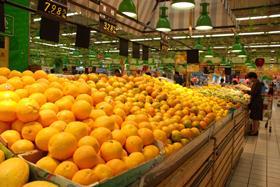
China’s insatiable demand for citrus has continued as the Southern Hemisphere campaign draws to a close with both South Africa and Australia recording record shipments to the Asian nation.
In the 12 months to the end of October, China had imported over 250,000 tonnes of citrus, mostly oranges and mandarins, from Southern Hemisphere suppliers, a 55 per cent increase over the previous year, according to China Customs data.
South Africa and Australia are the main Southern Hemisphere suppliers “in season” when China’s own producers and other Northern Hemisphere suppliers are out of season from July to November.
South African shipments increased 43 per cent year-on-year to 163,512 tonnes, while Australia saw even greater gains, sending 75,642 tonnes, up 70 per cent.
Peru has also made strong inroads in the China market, lifting over 300 per cent to 7,000 tonnes with shipments of mostly mandarins in July and August.
The growth in demand for Southern Hemisphere citrus adds to the overall increase in China’s citrus imports that have grown by 400 per cent since 2009 to reach some 460,000 tonnes. In 2009 South Africa supplied 5 per cent of imports while the US accounted for 85 per cent of the then 85,000 tonnes imported.
Fast forward to 2017 and the mix of suppliers has changed significantly. South Africa, Australia and other Southern Hemisphere suppliers now account for 54 per cent of China’s citrus imports while Egypt has become the leading Northern Hemisphere supplier with 22 per cent market share, followed by the US with 16 per cent. Spain has also gained market share, taking 4 per cent during the Northern Hemisphere season from January to June.
Explosive growth for Egypt
Egypt has been the big mover in the Northern Hemisphere season, emerging from shipments of just over 5,000 tonnes in 2014 to top 100,000 tonnes in 2017. China’s imports of Egyptian citrus reached 102,906 tonnes this year, up by some 200 per cent on 2016.
Egypt’s rapid rise has primarily afffected US suppliers. While Egypt could have more impact at the start of the Southern Hemisphere season, monthly data indicates Chinese buyers have switched to Southern Hemisphere supplies from Australia and South Africa as soon as their fruit becomes available.
Speaking to Asiafruit in April this year, Ignacio Smith of T&G Global’s China office said 2016/17 had been “a very active year for citrus [imports]'.
“Egypt is taking a larger piece of the business than anyone would have expected – at least when it comes to speed of sales on the market floor.”
While the growth of China’s citrus imports has been driven by a number of factors - from improved market access conditions to growing consumer demand - a key driver in 2016/17 appears to have been a shorter domestic citrus crop in China. China’s domestic citrus industry has been battling the impact of Huanglongbing, although a bigger crop is expected in 2017/18.



